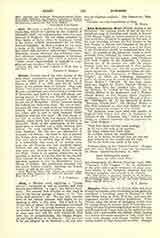

Alma Redemptoris Mater (Kindly Mother of the Redeemer), the opening words of one of the four Antiphons sung at Compline and Lauds, in honor of the Blessed Virgin, at various seasons of the year. This particular Antiphon is assigned to that part of the year occurring between the first Vespers of the first Sunday in Advent and Compline of the 2d of February (on which day it ceases, even if the Feast of the Purification should be transferred from that day). It consists of six hexameter verses in strict prosodial form, followed by versicle, response, and prayer, which vary for the season: until Christmas Eve (first Vespers of the Nativity), V. Angelus Domini etc., R. Et concepit etc., with the prayer Gratiam tuam etc.; thenceforward, V. Post partum etc., R. Dei Genitrix, etc., and the prayer Deus qui salutis ceternre etc. The hexameter verses are credited to Hermannus Contractus, or Hermann “the Cripple” (d. 1054), an interesting biographical notice of whom may be found in Duffield, “Latin Hymn Writers”, 149-168. It has been translated into English by Father Caswall (Mother of Christ, hear thou thy people’s cry); by Cardinal Newman, in “Tracts for the Times”, No. 75 (Kindly Mother of the Redeemer), and J. Wallace (Sweet Mother of Our Savior blest). Caswall’s translation is found in the official “Manual of Prayers” (Baltimore), 76. In the Marquess of Bute’s “Breviary; Winter Part”, 176 (Maiden! Mother of Him Who redeemed us, thou that abidest), the unrhymed hexameter version is very literal.
The Antiphon must have been very popular in England both before and after its treatment by Chaucer in his “Prioresses Tale”, which is based wholly on a legend connected with its recitation by the “Litel Clergeon”:
“This litel childe his litel book lerninge,
As he sat in the stole at his prymer,
He Alma redemptoris herde singe,
As children lerned hir antiphoner;
And, as he dorste, he drough hym ner and ner,
And herkned ay the wordes and the note,
Till he the firste vers coude al by rote.”
Professor Skeat, in his “Oxford Chaucer”, thought that the Alma Redemptoris here was the sequence (cf. Mone, Lateinische Hymnen, II, 200): Alma Redemptoris mater Quem de ccelis misit Pater but subsequently (cf. Modern Philology, April, 1906, “Chaucer’s `Litel Clergeon'”, for an explanation of the error and a good treatment of many questions related to the Antiphon) admitted that the Breviary Antiphon was referred to by Chaucer.
H. T. HENRY

